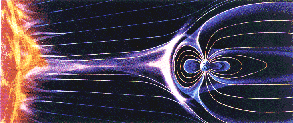This is an artist's rendering of solar wind coming towards the Earth and its magnetosphere.
Click on image for full size
NASA.
Solar Wind
The Sun is flinging 1 million tons of matter out into space every second! We call this material solar wind. Once the solar wind is blown into space, the particles travel at supersonic speeds of 200-800 km/sec! These particles travel all the way past Pluto and do not slow down until they reach the termination shock within the heliosphere. The Heliosphere is the entire region of space influenced by the Sun.
The solar wind plasma is very thin. Near the Earth, the plasma is only about 6 particles per cubic centimeter. So, even though the wind travels SUPER fast, it wouldn't even ruffle your hairif you were to stand in it because it's so thin! But, it is responsible for such unusual things as:
The particles of the solar wind, and the Sun's magnetic field (IMF) are stuck together, therefore the solar wind carries the IMF (interplanetary magnetic field)with it into space.
Instruments like SWICS and SWOOPS onboard the Ulysses probe are studying solar wind. They are hoping to make a 3-D map of solar wind characteristics throughout the heliosphere.
You might also be interested in:
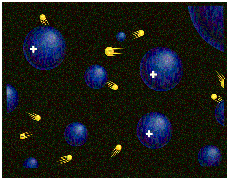
Plasma is known as the fourth state of matter. The other three states are solid, liquid and gas.In most cases, matter on Earth has electrons that orbit around the atom's nucleus. The negatively charged
...more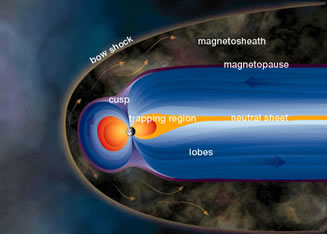
Motions within Earth's metallic core generate the planet's global magnetic field. This magnetic field extends beyond Earth's surface and atmosphere into the space surrounding our home planet. The interaction
...more
AU stands for Astronomical Units. It is a useful way to measure the distances in interplanetary space. It is the distance between the Earth and the Sun, which is about 93 million miles. For reference,
...more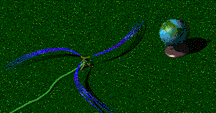
The solar wind is formed as the Sun's top layer blows off into space, carrying magnetic fields still attached to the Sun. Gusts form in the solar wind associated with violent events on the Sun. Particles
...more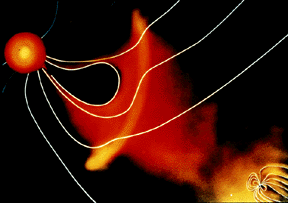
For a planet to be affected by a blob of material being ejected by the sun, the planet must be in the path of the blob, as shown in this picture. The Earth and its magnetosphere are shown in the bottom
...more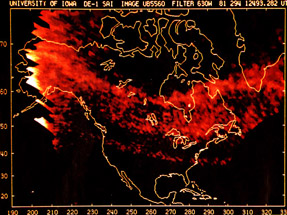
The aurora we are most familiar with is the polar aurora. This is what people are talking about when they say the northern or southern lights. But there are other less-known aurora, such as SAR arcs.
...more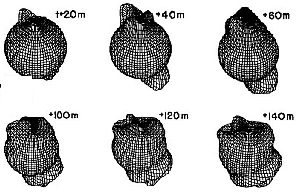
This figure shows the effect of the aurora on the atmosphere. When FAC's enter the atmosphere and create the aurora, they heat the atmosphere suddenly and abruptly. This creates an impulse which travels
...more


